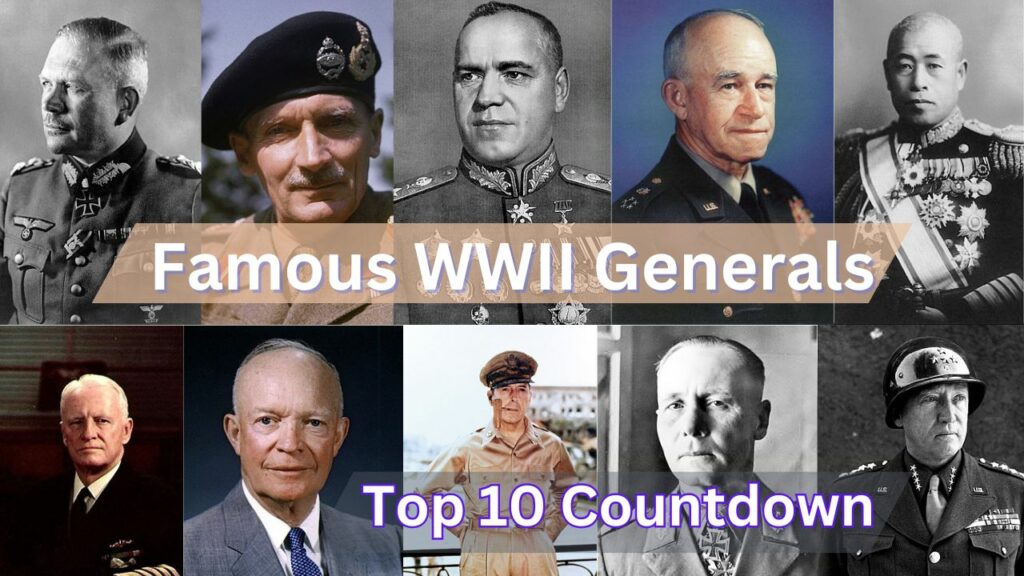
Out Top 10 Famous WWII Generals is one of many military Top 10 lists. Let’s start with an overview of who these famous WWII Generals are, then we will do a countdown with 10 facts about each man.
- Dwight D. Eisenhower: As Supreme Commander of Allied Forces in Europe during World War II, Eisenhower played a key role in the D-Day landings and the eventual defeat of Nazi Germany. He was known for his strategic planning skills and his ability to coordinate the efforts of different armies and nations.
- George S. Patton: Patton was a flamboyant and controversial American general who is best known for his leadership of the Third Army in Europe. He was known for his aggressive tactics and his relentless pursuit of the enemy, which earned him the nickname “Old Blood and Guts.”
- Bernard Montgomery: As commander of the British Eighth Army, Montgomery led the successful campaigns in North Africa and Italy, and played a key role in the Allied victory in Europe. He was known for his meticulous planning and his ability to inspire his troops.
- Douglas MacArthur: MacArthur was an American general who commanded the Pacific theater during World War II. He was known for his daring and sometimes controversial decisions, such as his decision to return to the Philippines and his use of atomic bombs on Japan.
- Georgy Zhukov: Zhukov was a Soviet general who played a key role in the defeat of Nazi Germany. He was known for his brilliant tactical skills and his ability to coordinate the efforts of different Soviet armies.
- Erwin Rommel: Rommel was a German general who earned the nickname “Desert Fox” for his successful campaigns in North Africa. He was known for his innovative tactics and his ability to outmaneuver his opponents.
- Heinz Guderian: Guderian was a German general who is credited with developing the concept of blitzkrieg, or “lightning war.” He was known for his innovative use of tanks and his ability to coordinate the efforts of different armored units.
- Omar Bradley: Bradley was an American general who commanded the U.S. First Army during the D-Day landings and played a key role in the Allied victory in Europe. He was known for his calm and steady leadership style and his ability to inspire his troops.
- Chester Nimitz: Nimitz was an American admiral who commanded the Pacific Fleet during World War II. He was known for his strategic planning skills and his ability to coordinate the efforts of different naval units.
- Isoroku Yamamoto: Yamamoto was a Japanese admiral who is best known for his role in planning the attack on Pearl Harbor. He was also responsible for many of Japan’s naval strategies during the war and was known for his innovative tactics and his ability to outmaneuver his opponents.
Generals Countdown list starts now. . .
10. Isoroku Yamamoto
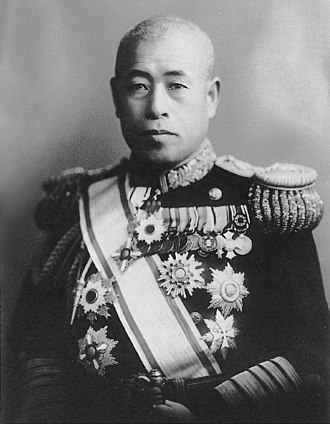
Isoroku Yamamoto was a Japanese Marshal Admiral and the commander-in-chief of the Combined Fleet during World War II. He was one of Japan’s foremost naval strategists and played a critical role in planning Japan’s surprise attack on Pearl Harbor.
10 Interesting Facts about Isoroku Yamamoto:
- Yamamoto was born in Japan in 1884 and was a graduate of the Japanese Naval Academy.
- He spent two years in the United States as a naval attaché, becoming fluent in English and gaining a deep understanding of American naval strategy.
- Yamamoto was a strong advocate for the Pearl Harbor attack, but he was also a realist who knew the odds were against Japan in a prolonged conflict with the United States.
- He personally commanded several key naval battles, including the Battle of Midway in 1942.
- Yamamoto was known for his calm demeanor and analytical mind, but he also had a softer side – he was an accomplished poet and calligrapher.
- He was strongly opposed to the idea of war with the United States, but he ultimately carried out his orders as a loyal officer.
- Yamamoto was responsible for the development of the Japanese “Zero” fighter, which was one of the most advanced aircraft of its time.
- He was known for his emphasis on training and discipline, which he believed were crucial for success in battle.
- Yamamoto was shot down and killed in 1943 when American forces intercepted and decoded a message revealing his travel plans.
- Despite his role in planning the Pearl Harbor attack, Yamamoto was respected by many in the United States military, who recognized his strategic genius and tactical skill.
Concluding statement:
Isoroku Yamamoto was a brilliant naval commander who played a key role in Japan’s early successes in World War II. Despite his success on the battlefield, he was a man who understood the human cost of war and who ultimately paid the ultimate price for his loyalty to his country. His legacy lives on as one of the most respected military strategists of the 20th century.
9. Chester Nimitz
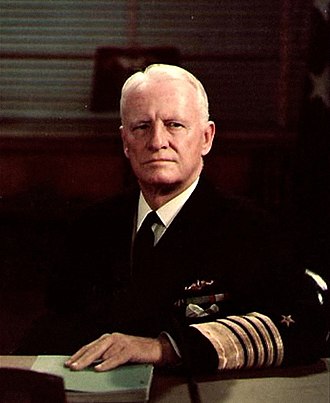
Chester Nimitz was a United States Navy admiral who played a major role in the Pacific theater during World War II. He is considered one of the greatest naval commanders in American history. Nimitz was known for his strategic leadership and his ability to inspire his troops to achieve victory against formidable enemies.
10 Interesting Facts About Chester Nimitz:
- Nimitz was born in Fredericksburg, Texas, in 1885 and grew up on a farm.
- He attended the United States Naval Academy and graduated seventh in his class in 1905.
- Nimitz served in both World War I and World War II, rising to the rank of fleet admiral.
- He was in command of the U.S. Pacific Fleet during the attack on Pearl Harbor in 1941.
- Despite the surprise attack, Nimitz quickly organized a counterattack and led the United States to victory in the Pacific.
- Nimitz played a key role in the Battle of Midway, which is considered one of the most significant naval battles of the war.
- After the war, Nimitz served as Chief of Naval Operations, the highest-ranking officer in the U.S. Navy.
- He was a strong advocate for nuclear submarines and played a key role in the development of the nuclear-powered fleet.
- Nimitz was awarded numerous honors for his service, including the Presidential Medal of Freedom and the Navy Distinguished Service Medal.
- Nimitz passed away in 1966, but his legacy as one of America’s greatest naval heroes lives on.
In summary
Chester Nimitz was an extraordinary leader who played a crucial role in the American victory in World War II. His strategic vision and tactical brilliance helped turn the tide in the Pacific and ultimately lead to Japan’s surrender. Nimitz’s contributions to the development of the U.S. Navy and his legacy as a military hero continue to inspire generations of Americans.
8. Omar Bradley
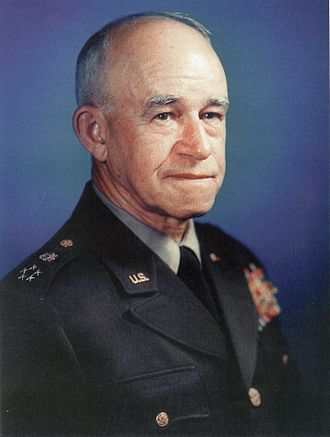
Omar Bradley was an American general who served in World War II and later became the first Chairman of the Joint Chiefs of Staff.
Interesting facts about Omar:
- He was known as the “GI’s General” for his deep concern for the welfare of the soldiers under his command.
- Bradley led the American forces during the Normandy landings in 1944, which played a pivotal role in the Allies’ victory in Europe.
- He was one of the few senior officers to question the use of atomic bombs in Japan, arguing that they were not necessary to end the war.
- Bradley was awarded the Army Distinguished Service Medal five times, making him one of the most decorated soldiers in U.S. history.
- He was the last surviving five-star general of the United States Army and died in 1981 at the age of 88.
- Bradley was a mentor to many other generals, including Dwight D. Eisenhower and George S. Patton.
- He was also an advocate for desegregation in the military, pushing for the integration of African-American troops.
- After the war, he served as the administrator of the Veterans Administration, overseeing the care of millions of returning veterans.
- Bradley was known for his modesty and lack of self-promotion, often deflecting credit for his successes onto his troops.
- In 1949, he published his memoir, “A Soldier’s Story,” which remains a classic account of the war from a top general’s perspective.
Conclusion:
Omar Bradley was a legendary American general who played a critical role in the Allied victory in Europe during World War II. His deep concern for his troops, strategic brilliance, and commitment to justice and equality made him a beloved and respected leader both during and after the war. His legacy lives on as a model of military leadership and service to his country.
7. Heinz Guderian
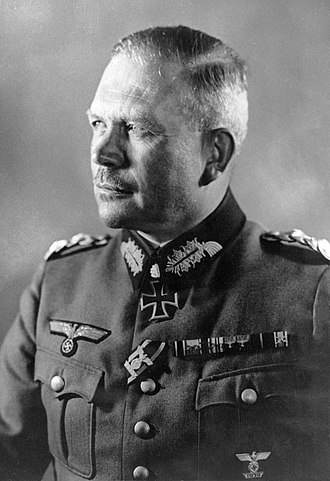
Heinz Guderian was a German general and tank warfare pioneer who played a key role in developing Germany’s Panzer forces.
10 interesting facts about Heinz Guderian:
- He is often called the “father of the Blitzkrieg” for his role in developing the strategy.
- He was one of the first officers to recognize the importance of tanks in modern warfare.
- During World War II, he commanded the German Second Panzer Army and played a key role in several major battles.
- Guderian was a prolific writer and wrote several influential books on military strategy and tactics.
- He was also a strong advocate for the use of air power in warfare.
- Despite his successes, Guderian clashed with Hitler and was dismissed from his command in 1945.
- He was briefly imprisoned by the Allies after the war but was released without charge.
- Guderian was a talented amateur musician and played the piano and violin.
- He was a devout Lutheran and his religious beliefs played a significant role in his life.
- Guderian died in 1954 and was buried with full military honors.
Conclusion:
Heinz Guderian was a brilliant military strategist and one of the foremost pioneers of tank warfare. His ideas and innovations had a profound impact on the German military and his legacy continues to influence military thinking to this day. Though he was dismissed from his command and briefly imprisoned after the war, Guderian’s contributions to military history are undeniable.
6. Erwin Rommel
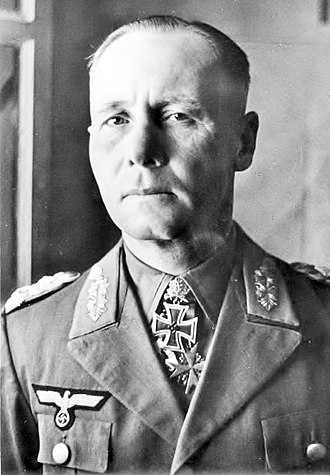
Erwin Rommel, the “Desert Fox,” was a highly decorated German field marshal during World War II, known for his daring tactics during World War II.
10 interesting facts about Erwin Rommel:
- Rommel was born in 1891 in the small German town of Heidenheim.
- Before the war, Rommel served in the German Army as an officer and gained fame for his leadership during World War I.
- He wrote a book called “Infantry Attacks” which was used as a manual for the German army and other armies around the world.
- Rommel gained notoriety for his unconventional tactics during the North African campaign, including his use of rapid mobile warfare.
- He was highly respected by both his own troops and his enemies, including British generals who later referred to him as a “great soldier.”
- Rommel was forced to commit suicide by the Nazi regime after he was implicated in a plot to assassinate Hitler in 1944.
- He was known for his military discipline and his ability to inspire his troops to fight bravely.
- Rommel was one of the most successful commanders of his time, winning many battles against the Allies despite being outnumbered and outgunned.
- His early victories in North Africa made him a hero in Germany and helped to boost morale during the early years of the war.
- Rommel is remembered as a brilliant strategist and a charismatic leader who fought for his country with honor and courage.
Concluding statement:
Erwin Rommel was a complex figure who remains a fascinating and controversial figure in military history. His daring tactics, military discipline, and charisma continue to inspire and intrigue people around the world. Despite his association with the Nazi regime, his military achievements and personal courage have earned him a place among the most respected military leaders of the 20th century.
5. Georgy Zhukov
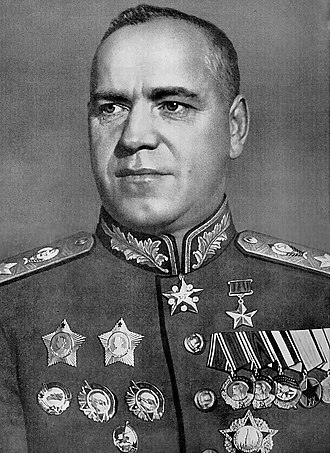
Georgy Zhukov, the Soviet military commander, was a key strategist during WWII. He played a significant role in the Eastern Front battles.
10 Interesting facts about Georgy Zhukov:
- He rose to fame by commanding the Soviet Union’s victory over the Japanese in the Battle of Khalkhin Gol in 1939.
- Zhukov was one of the few Soviet generals who dared to challenge Joseph Stalin’s leadership.
- He was the chief of the general staff during the Battle of Stalingrad, one of the bloodiest battles in history.
- Zhukov led the Soviet Union’s victory in the Battle of Kursk, the largest tank battle in history.
- He was instrumental in the Soviet Union’s success in the Battle of Berlin.
- Zhukov was awarded the title of Hero of the Soviet Union four times.
- He played a critical role in the planning of the Battle of Moscow, which saved the Soviet Union from defeat in the early stages of the war.
- After the war, Zhukov served as the Soviet Union’s Minister of Defense and played a significant role in modernizing the Soviet military.
- He was known for his straightforward and direct leadership style, which earned him respect from both his superiors and subordinates.
- Zhukov was removed from power by Nikita Khrushchev in 1957 and sent into forced retirement, but he remained a popular figure in the Soviet Union.
Conclusion
Georgy Zhukov’s contributions to the Soviet Union’s success in WWII and his continued service to the country afterward cemented his place in history as one of the greatest military commanders of all time.
4. Douglas MacArthur
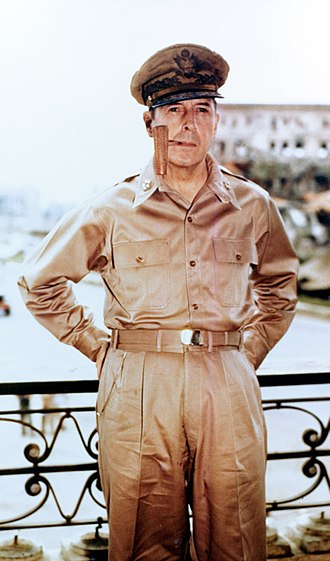
Douglas MacArthur was an American general who served in both World War I and World War II, as well as in the Korean War. He is widely regarded as one of the most controversial and iconic figures in American military history, known for his bold leadership style and his role in shaping American foreign policy in the mid-20th century.
Interesting Facts about Douglas MacArthur:
- MacArthur was born in 1880 in Little Rock, Arkansas and was raised in a military family.
- He attended West Point and graduated first in his class in 1903.
- MacArthur served in World War I as the commander of the 42nd “Rainbow” Division and was awarded the Distinguished Service Cross for bravery.
- He was appointed Chief of Staff of the US Army in 1930 and played a key role in modernizing the army and expanding its capabilities.
- During World War II, MacArthur commanded Allied forces in the Pacific theater and oversaw major victories at the Battle of the Philippines and the Battle of Leyte Gulf.
- He famously proclaimed “I shall return” after being forced to evacuate the Philippines in 1942 and successfully led the Allied forces in their campaign to retake the islands.
- MacArthur was a controversial figure, known for his bold and often controversial decisions, including his decision to invade Incheon during the Korean War.
- He was relieved of his command by President Truman in 1951 after publicly criticizing Truman’s policy of limited war in Korea.
- MacArthur delivered a famous farewell address to Congress in 1951, in which he declared “Old soldiers never die; they just fade away.”
- He died in 1964 at the age of 84 and was buried at the United States Military Academy at West Point.
Concluding Statement:
Douglas MacArthur was a larger-than-life figure whose bold leadership style and contributions to American military history continue to be studied and debated to this day. Though he was known for his controversial decisions and clashes with political leaders, his military career was marked by a series of impressive victories and strategic successes. MacArthur’s legacy as one of America’s most iconic military leaders is secure, and his impact on the nation’s military strategy and foreign policy will be felt for generations to come.
3. Bernard Montgomery
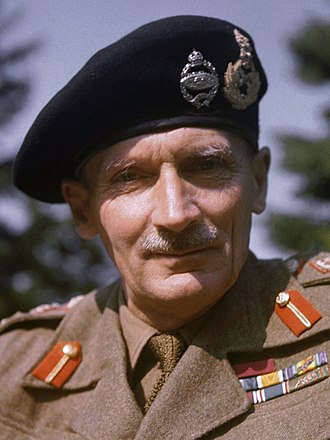
Bernard Montgomery, born in London in 1887, was one of the most celebrated British generals of World War II. He is most famous for his leadership of the British Eighth Army in North Africa and his victory at the Battle of El Alamein.
Interesting Facts about Bernard Montgomery:
- Montgomery was a strict disciplinarian and was known for his no-nonsense approach to leadership.
- He was a highly skilled tactician and strategist, and was instrumental in the Allied victory in North Africa.
- Montgomery’s nickname was “Monty,” and he was known for his trademark beret and his love of cigars.
- He was a deeply religious man and carried a bible with him wherever he went.
- Montgomery was notoriously difficult to work with and had a reputation for being stubborn and argumentative.
- He was involved in some of the most important battles of the war, including El Alamein and the Normandy landings.
- Montgomery was an early advocate for the use of airborne forces in warfare, and played a key role in the development of the British airborne division.
- He was awarded the title of Viscount Montgomery of Alamein in recognition of his military service.
- Montgomery was known for his attention to detail, and would often spend hours studying maps and plans before a battle.
- He was a strong believer in the importance of morale, and made sure that his troops were well-fed, well-equipped, and well-rested before a battle.
Concluding Statement:
Bernard Montgomery was a complex and controversial figure whose military genius was instrumental in the Allied victory in World War II. Though he was often difficult to work with and had a reputation for being argumentative, his strict discipline, strategic brilliance, and attention to detail inspired his troops to achieve greatness. Montgomery’s legacy is a testament to the power of leadership and the importance of perseverance in the face of adversity.
2. George S. Patton
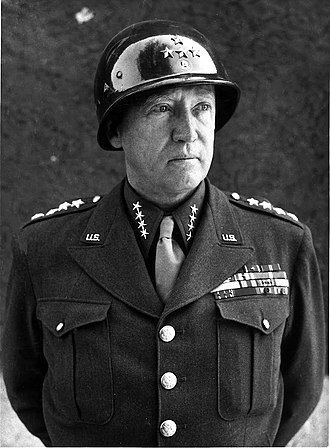
George S. Patton was a charismatic and controversial general in the United States Army who is best known for his leadership during World War II. A colorful character with a larger-than-life personality, Patton was known for his bold tactics and unapologetic approach to war.
Interesting Facts about Patton:
- Patton was born in California in 1885 to a wealthy family with a long military tradition.
- He attended West Point and was commissioned as a second lieutenant in the cavalry in 1909.
- During World War I, Patton served as a tank commander and was wounded in battle.
- He was instrumental in developing the tactics and strategies used by American tank units during the war.
- Patton was a brilliant military strategist and was known for his aggressive tactics on the battlefield.
- He was a devout Christian and believed that God had chosen him to be a great military leader.
- Patton was notoriously strict with his troops, believing that discipline was essential to victory.
- He was a master of motivational speeches and was known for his ability to inspire his troops to greatness.
- Patton was an accomplished athlete and competed in the modern pentathlon at the 1912 Olympics.
- He was the subject of the Academy Award-winning film “Patton,” which was released in 1970.
Concluding Statement:
George S. Patton was a complex and controversial figure who was both revered and reviled by those who knew him. He was a brilliant military strategist and a charismatic leader, but his unapologetic approach to war and his strict discipline often put him at odds with his fellow generals. Despite his flaws, Patton’s contributions to American military history cannot be denied, and his legacy as a bold and daring commander continues to inspire new generations of soldiers and leaders.
1. Dwight D. Eisenhower
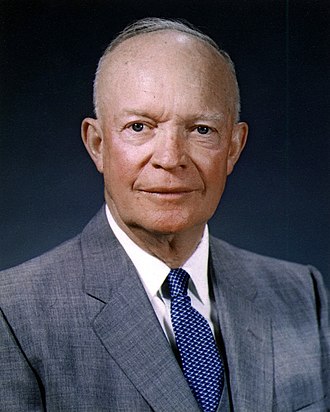
Dwight D. Eisenhower, affectionately known as “Ike,” was a five-star general in the United States Army and the 34th President of the United States. He played a key role in World War II and is considered one of the greatest military commanders in U.S. history.
Interesting Facts about Dwight:
- Eisenhower graduated from West Point in 1915.
- He served as General Douglas MacArthur’s aide in the Philippines in the 1930s.
- During World War II, Eisenhower was the Supreme Commander of the Allied Forces in Europe.
- He was responsible for planning and executing the D-Day invasion in 1944.
- Eisenhower served as President of Columbia University from 1948-1950.
- He was the first Supreme Commander of NATO.
- Eisenhower was elected President in 1952 and re-elected in 1956.
- His domestic policies included the Interstate Highway System and the Civil Rights Act of 1957.
- Eisenhower was the first President to fly in a helicopter.
- He suffered a heart attack while in office in 1955.
Concluding Statement:
Dwight D. Eisenhower was a towering figure in American history, serving with distinction both on the battlefield and in the Oval Office. He was a leader who commanded respect and admiration from his troops and fellow citizens alike, and his legacy as a great military strategist and statesman continues to inspire us today.
You can also find more resources for WWII Generals. Why not visit another Top 10 Famous Persons list?
